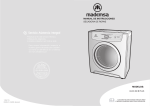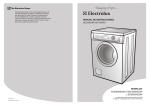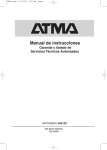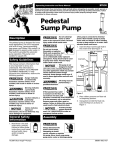Download JVC KS-AR9501D User's Manual
Transcript
KS-AR9501D LVT1969-001A POWER AMPLIFIER: INSTRUCTIONS AMPLIFICADOR DE POTENCIA: MANUAL DE INSTRUCCIONES 0109MNMMDWTKC EN, SP © 2009 Victor Company of Japan, Limited [J, K] TERMINAL CONNECTIONS ENGLISH When making the terminal connections… 1 Peel the insulating vinyl cover of a cord 7 mm (5/16 inch) to 10 mm (7/16 inch) long and expose the inside conductor. 2 Loosen the hex screw in a terminal with a provided hex wrench and insert the conductor into the terminal. Then fix the hex screw again to secure the conductor. Note • The exposed conductor should be 7 mm (5/16 inch) to 10 mm (7/16 inch) long. – If shorter, it may cause a poor conductivity. – If longer, it may cause a short circuit. • Use a proper hex wrench for each terminal. – 4 mm: +B terminal and GND terminal – 3 mm: REM terminal and speaker terminals Thank you for purchasing a JVC product. Please read all instructions carefully before operation, to ensure your complete understanding and to obtain the best possible performance from the unit. This unit is designed to be connected to subwoofers. For safety.... POWER SUPPLY • Do not raise the volume level too much, as this will block outside sounds, making driving dangerous. • Stop the car before performing any complicated operations. CAUTIONS AND NOTES This unit is designed to operate on 12 V DC, NEGATIVE ground electrical systems. • This unit uses BTL (Balanced Transformerless) amplifier circuitry, i.e., floating ground system, so please comply with the following: Do not connect the “·” terminals of the speakers to each other. Do not connect the “·” terminals of the speakers to the metal body or chassis. • Cover the unused terminals with insulating tape to prevent them from short circuiting. • When an extension lead is used, it should be as thick and short as possible; connect it firmly with insulating tape. • Be sure to leave an appropriate space between the antenna and the wires of this unit. • When replacing the fuse, only use a 30 A fuse. • Do not let pebbles, sand or metallic objects get inside the unit. • To keep the heat dissipation mechanism running effectively, wipe the accumulated dust off periodically. • Listening to the tape, radio, CD or Digital Audio Player, etc. with the volume set at a high level for a long period of time will exhaust the battery, while the engine is turned off or while the engine is idling. • This unit becomes very hot. Be careful not to touch the unit not only when using but for a while after using. * Not included with this unit. To metallic body or chassis (To an accessory terminal) 120 A Fuse Remote turn-on line CAUTION For Customer Use: Enter below the Model No. and Serial No. which are located on the top or bottom of the cabinet. Retain this information for future reference. The proper lead wire connected to each POWER terminal is as follows. • + B and GND: AWG 4 (The cross section is about 21 mm2.) • REM: AWG 18 to AWG 8 (The cross section is about 0.8 mm2 to 8 mm2.) Serial No. • If you have any questions regarding the thickness of the power cord, etc., consult your nearest JVC car audio dealer. a When you use JVC car receiver with a remote lead, connect to the REM terminal on this unit. b When you connect a unit without a remote lead, connect to the accessory circuit of the car which is activated by the ignition switch. In this case, noise may occur when the car receiver is turned on or off. To avoid this noise, do not turn on or off the car receiver itself. You can turn on or off the car receiver along with the on/off operation of the ignition switch. If the POWER/PROTECTOR lamp lights in red, it indicates incorrect speaker wiring or connections (see “TROUBLESHOOTING” on page 3). Make sure to correct speaker wiring and other connections. INSTALLATION The following illustration shows a typical installation. However, you should make adjustments corresponding to your specific car. If you have any questions or require information regarding installation kits, consult your JVC car audio dealer or a company supplying the kits. A Mount this unit on a firm surface, such as in the trunk room or under the front seat. • Since heat is generated in the unit, do not mount it near inflammable objects. In addition, mount it in an area that will not prevent the unit from dissipating the heat. • Do not mount the unit in the places subject to heat: near a radiator, in a glove compartment or in insulated areas such as under a car mat that will prevent the unit from dissipating heat. • When mounting the unit under the front seat, make sure that adjusting the seat position will not catch any wire of the unit. B When mounting this unit, be sure to use the provided screws. If any other screws are used, the unit may not be fixed firmly or parts inside the unit may be damaged. • Before drilling holes in the trunk to install the unit, make sure that sufficient space exists under the trunk so that you do not drill holes in the fuel tank, etc. • To detach and rotate the Logo Plate, use the provided hex wrench (2.5 mm). C When you use more than one KS-AR9000 series amplifier, you can pile them up to three with provided brackets, screws and washers in two ways, X or Y. Be sure to mount the lowest amplifier (1) primarily following B. • Before piling amplifiers, attach the provided spacers to the “+” marks on the bottom of the amplifiers 2 and 3. • Before piling amplifiers as X, first make the connections for the power supply (see “POWER SUPPLY”) and speakers (see “SPEAKER CONNECTIONS” on page 2). A B SPEAKER SYSTEMS Make sure to comply with the following notes: • Be sure not to connect the “·” terminals of the speakers to a common point. • If the ground wire is common to both left/right and front/rear speaker wirings, this unit cannot be used. Always use the independent lead wires for the speakers to be used. In this case, redo the wirings. • Use the speakers with an impedance of 1 Ω to 8 Ω (2 Ω to 8 Ω when used in External Bridge Mode). • Use the speakers which have sufficient capacity to the unit. The proper lead wire connected to each SPEAKER OUTPUT terminal is as follows. AWG 18 to AWG 8 (The cross section is about 0.8 mm2 to 8 mm2.) C X Screw—Dia. 4 mm (3/16 inch) × 20 mm (13/16 inch) Logo Plate (detachable) JVC car receiver, etc. To prevent short circuits while making connections, keep the battery’s negative terminal disconnected. • When using a power cord (purchased separately), be sure to place the 120 A fuse near the battery as shown. • Connect the lead wire (power cord) through which power is supplied directly to the battery’s “ª” terminal only after all the other connections have been made. DO NOT disassemble the units since there are no user serviceable parts inside. Model No. Ignition switch Car battery Y Bracket Bracket Spacer's bottom Onto the trunk room floor Bottom Under the front seat Spacer Spacer Hex screw Drilled hole 1 EN_KS-AR9501D[JK]-4.indd 1 08.12.23 4:30:29 PM SPEAKER CONNECTIONS Connection varies depending on the number of the speakers used in your car. Select the appropriate connection referring to the following diagrams. Before connecting: Securely connect all the parts. If the connections are loose, due to contact resistance etc., heat will break out and may cause an accident. Secure and cover the cords with insulating tape and run them under the car mats. Subwoofer system (1 amplifier) 2-subwoofer system (1 amplifier) JVC car receiver, etc. JVC car receiver, etc. Line Out (Rear) or Subwoofer Out Line Out (Rear) or Subwoofer Out Subwoofer*2 Subwoofer*3 Note Use the subwoofer with an impedance of 1 Ω to 8 Ω. Subwoofer*3 Note Use the subwoofers with an impedance of 2 Ω to 8 Ω. 2-subwoofer system (2 amplifiers) 4-speaker system plus subwoofer—5.1-channel (3 amplifiers) JVC amplifier, etc. (purchased separately) JVC car receiver, etc. Line Out (Rear) or Subwoofer Out Line Out (Front) Line Out (Rear) Front Speaker Rear Speaker (left/right) (left/right) JVC car receiver, etc. Line Out (Center) Subwoofer Out Subwoofer*2 Subwoofer*2 JVC amplifier, etc. (purchased separately) Subwoofer*2 Center Speaker Note • Use the subwoofers with an impedance of 1 Ω to 8 Ω. • Incoming signals are emitted through the PRE OUT jacks. Note Use the subwoofer with an impedance of 1 Ω to 8 Ω. Subwoofer system (2 amplifiers)—External Bridge Mode JVC car receiver, etc. *1 *2 *3 *4 Line Out (Rear) or Subwoofer Out Not provided for this unit. You can connect 2 subwoofers as shown in “Example 1” to “Example 4” below. You can connect 2 subwoofers as shown in “Example 2” to “Example 4” below. Be sure to connect the line output from the receiver to the left (L) jack on this unit. Examples for connecting 2 subwoofers Amplifier A Example 1 Load impedance: 1 Ω Example 3 Load impedance: 4 Ω Subwoofer (Dual 4 Ω) Subwoofer*3 Subwoofer (Dual 4 Ω) Speaker Wire Subwoofer (Dual 4 Ω) Subwoofer (Dual 4 Ω) Amplifier B Example 2 Load impedance: 2 Ω Note • Use the subwoofer with an impedance of 2 Ω to 8 Ω. • Use the subwoofer which have sufficient capacity to the unit. • Make sure to set the EXTERNAL BRIDGE switch as illustrated above; otherwise, the sound may be distorted. • You cannot adjust the sound on the amplifiers separately. The adjustment on the amplifier A is also applied to the amplifier B. Example 4 Load impedance: 8 Ω Subwoofer (4 Ω) Subwoofer (4 Ω) Subwoofer (4 Ω) Subwoofer (4 Ω) 2 EN_KS-AR9501D[JK]-4.indd 2 08.12.23 4:30:31 PM TROUBLESHOOTING CONTROLS For more details, consult your JVC car audio dealer. The POWER/PROTECTOR lamp does not light. • Change the fuses if the current one is blown. • Connect the ground lead securely to a metal part of the car. • Turn on the equipment connected to this unit. • Use a relay if your system employs too many amplifiers. • Confirm the battery voltage (11 V to 16 V). Hex screw The POWER/PROTECTOR lamp lights in red and/or the unit heats up abnormally. • Use the speakers of suitable impedance. • Correct the speaker wirings if they are short-circuited. • Make the speaker wirings away from the power cord to prevent DC offset error. • Leave the unit turned off for a while to cool it down. No sound is heard. • Confirm the connections for power supply (see “POWER SUPPLY” on page 1). • Connect RCA pin cords to the INPUT jacks firmly. Hex wrench (2.5 mm) Alternator noise is heard. • Keep the power cords away from the RCA pin cords. • Keep the RCA pin cords away from other electrical cables in the car. • Connect the ground lead securely to a metal part of the car. • Make sure the negative speaker leads do not touch the car chassis. • Replace the plugs or use plugs with load resistors. • Connect a bypass capacitor across the accessory switches (horn, fan, etc.). Control cover To operate the following controls, remove the hex screws with a provided hex wrench (2.5 mm) and detach the control cover. Attach it again after your operation. Noise is made when you connect the unit to an AM tuner. • Move the speaker and power cords away from the antenna lead. SPECIFICATIONS Power Output Signal-to-Noise Ratio Power Output Input LEVEL controller The input level can be adjusted with this controller when this unit is connected to other source equipment. Adjust the level while listening to the sound. This controller is preset to MIN when the unit is shipped. LPF (Low-Pass Filter) controller Adjust the cutoff frequency (the Low-Pass Filter transmits frequencies lower than the cutoff frequency) within the range of 50 Hz to 300 Hz. Adjust the level while listening to the sound. This controller is preset to 50 Hz when the unit is shipped. PHASE switch Select either normal (NOM) or reverse (REV), which reproduce a better sound. This switch is preset to NOM when the unit is shipped. BASS BOOST controller Turning this boosts the 45 Hz frequency within the range of 0 dB to +18 dB. Adjust the level while listening to the sound. This controller is preset to MIN when the unit is shipped. SUBSONIC filter controller Adjust the cutoff frequency (the subsonic filter rejects frequencies lower than the cutoff frequency) within the range of 20 Hz to 50 Hz. This controller is preset to 20 Hz when the unit is shipped. POWER/PROTECTOR lamp The lamp lights in green while the unit is turned on. If the lamp does not light or lights in red with the unit on, some trouble has occurred (see “TROUBLESHOOTING”). Power indicator The blue lamp illuminates while the unit is turned on. Maximum Power Output Load Impedance Frequency Response Input Sensitivity/Impedance Distortion Power Requirement Grounding system Dimensions (W×H×D) Mass (approx.) Supplied Accessories • Normal Mode: 500 W RMS x 1 channel at 4 Ω and ≤ 1% THD + N 60 dBA (reference: 1 W into 4 Ω) • Normal Mode: 1 000 W RMS x 1 channel at 2 Ω and ≤ 1% THD + N 1 500 W RMS x 1 channel at 1 Ω and ≤ 1% THD + N • Normal Mode: 1 800 W • External Bridge Mode: 3 000 W • Normal Mode: 4 Ω (1 Ω to 8 Ω allowance) • External Bridge Mode: 2 Ω (2 Ω to 8 Ω allowance) 20 Hz to 300 Hz* (+0, –3 dB) * Subsonic filter cuts off extremely low frequency signals. (The cutoff frequency is adjustable within the range of 20 Hz to 50 Hz.) 2 V/45 kΩ (0.3 V to 6 V, variable) Less than 0.1% (at 100 Hz) DC 14.4 V (11 V to 16 V allowance) Negative ground 360 mm × 60 mm × 245 mm (14 3/16 inch × 2 3/8 inch × 9 11/16 inch) 5.00 kg (11.02 lbs.) Screw—Dia. 4 mm (3/16 inch) × 20 mm (13/16 inch) × 4 Hex wrench 4 mm × 1 3 mm × 1 2.5 mm × 1 Spacer × 4 Bracket × 2 Hex screw—M4 × 12 mm (1/2 inch) × 6 Wired remote control unit: RM-RK130 (purchased separately) Design and specifications are subject to change without notice. Using JVC’s wired remote control unit: RM-RK130 (purchased separately), you can adjust the bass boost in your seat without adjusting the BASS BOOST controller on the amplifier (see “CONTROLS”). Note Set the BASS BOOST controller on the amplifier to MIN when you use RM-RK130. A Mount RM-RK130 on a firm surface, such as under the dashboard. B Connect RM-RK130 to the REMOTE terminal on the amplifier with the remote cord provided for RM-RK130. C RM-RK130 boosts the 45 Hz frequency within the range of 0 dB to +18 dB. Adjust the level while listening to the sound. • The POWER lamp lights in green while RM-RK130 is turned on. A Under the dashboard, etc. B C [European Union only] Drilled hole POWER lamp Remote cord (provided for RM-RK130) Screw—Dia. 4 mm (3/16 inch) × 12 mm (1/2 inch) (provided for RM-RK130) BASS BOOST controller RM-RK130 3 EN_KS-AR9501D[JK]-4.indd 3 08.12.23 4:30:32 PM CONEXIONES DE LOS TERMINALES ESPANÕL Cuando realice las conexiones de los terminales... 1 Retire la cubierta aislante de vinilo de un cable de 7 mm a 10 mm de largo de manera que el conductor interior quede al descubierto. 2 Afloje el tornillo hexagonal del terminal con la llave hexagonal suministrada e inserte el conductor en el terminal. Luego vuelva a fijar el tornillo hexagonal para asegurar el conductor. Nota • El conductor al descubierto debe ser de un largo de 7 mm a 10 mm. – Un largo menor podrá causar una mala conductividad. – Un largo mayor podrá causar un cortocircuito. • Utilice una llave hexagonal apropiada para cada terminal. – 4 mm: Terminal + B y terminal GND – 3 mm: Terminal REM y terminales de los altavoces Muchas gracias por la compra de un producto JVC. Como primer paso, por favor lea detenidamente este manual para comprender a fondo todas las instrucciones y obtener un máximo disfrute de esta unidad. Esta unidad se ha diseñado para ser conectada a subwoofers. Para fines de seguridad.... FUENTE DE ALIMENTACIÓN • No aumente excesivamente el nivel de volumen, pues es muy peligroso conducir si no se escuchan los sonidos exteriores. • Detenga el automóvil antes de efectuar cualquier operación complicada. PRECAUCIONES Y NOTAS Esta unidad está diseñada para operar con sistemas eléctricos de 12 V CC, con NEGATIVO a masa. • Esta unidad emplea un circuito amplificador BTL (sin transformador equilibrado), es decir, un sistema de masa flotante y por lo tanto debe cumplir con lo siguiente: No conecte entre sí los terminales “·” de los altavoces. No conecte los terminales “·” de los altavoces a la carrocería metálica ni al chasis. • Cubra los terminales que no están en uso con cinta adhesiva, para evitar cortocircuitos. • Si utiliza un cable prolongador, éste debe ser lo más grueso y corto posible; conéctelo firmemente con cinta aislante. • Asegúrese de dejar un espacio adecuado entre la antena y los cables de esta unidad. • Cuando sea necesario cambiar el fusible, utilice solamente un fusible de 30 A. • Impida la entrada de objetos metálicos, arena o piedrecillas dentro de la unidad. • Para mantener en funcionamiento efectivo el mecanismo de disipación de calor, limpie periódicamente el polvo acumulado. • La batería se descargará si escucha una cinta, radio, CD o reproductor de audio digital, etc. a un volumen alto por un tiempo prolongado, con el motor apagado o funcionando al ralentí. • La unidad estará muy caliente. Tenga la precaución de no tocarla, no sólo durante el uso, sino hasta un cierto tiempo después del uso. * Not suminstrado con esta unidad. A un cuerpo metálico o chasis (A un terminal accessorio) Fusible de 120 A Línea de conexión remota Interruptor de encendido Batería del automóvil Receptor para automóvil de JVC, etc. PRECAUCION Para evitar cortocircuitos durante las conexiones, mantenga desconectado el terminal negativo de la batería. • Cuando utilice un cable de alimentación (vendido separadamente), asegúrese de colocar un fusible de 120 A cerca de la batería, tal como se observa en la ilustración. • Conecte el conductor principal (cable de alimentación) a través del cual se suministra directamente la alimentación al terminal “ª” de la batería únicamente después de realizar todas las conexiones restantes. NO desarme la unidad; en el interior no hay piezas que pueda reparar el usuario. INSTALACION La siguiente ilustración muestra una instalación típica. Sin embargo usted deberá efectuar los ajustes correspondientes a su automóvil. Si tiene alguna pregunta o necesita información acerca de las herramientas para instalación, consulte con su concesionario de JVC de equipos de audio para automóviles o a una compañía que suministra tales herramientas. A Instale esta unidad sobre una superficie firme, como en el baúl o debajo del asiento delantero. • Debido a que se genera calor en la unidad, no lo instale cerca de objetos inflamables. Asimismo, instale la unidad en un lugar que no impida la disipación de calor. • No coloque la unidad cerca de fuentes de calor, como el radiador, la guantera o los lugares aislados como debajo de la alfombra, porque la unidad no podrá disipar el calor. • Cuando instale la unidad debajo del asiento delantero, asegúrese de ajustar la posición del asiento de manera que no quede atrapado ningún cable de la misma. B Al instalar esta unidad, asegúrese de utilizar los tornillos suministrados. El uso de otros tornillos podrá provocar una fijación incorrecta o daños en las piezas del interior de la unidad. • Antes de perforar orificios en el baúl para instalar la unidad, asegúrese que haya suficiente espacio debajo del baúl ya que podría llegar a perforar el depósito de combustible, etc. • Para desmontar y girar la placa del logotipo, utilice la llave hexagonal suministrada (2,5 mm). C Cuando se utilice más de un amplificador de la serie KS-AR9000, es posible apilarlos a una altura máxima de tres unidades de dos modos distintos (X o Y) mediante los soportes, los tornillos y las arandelas suministrados. Asegúrese de montar en primer lugar el amplificador más bajo (1) tal y como se indica en B. • Antes de apilar los amplificadores, acople los separadores suministrados en “+” en la parte inferior de los amplificadores en 2 y 3. • Antes de apilar los amplificadores como se indica en X, realice primero las conexiones de alimentación (ver “FUENTE DE ALIMENTACIÓN”) y de los altavoces (ver “CONEXIONES DE LOS ALTAVOCES” en la página 2). A continuación se indica el conductor principal apropiado que se debe conectar a cada terminal POWER. • + B y GND: La sección transversal es de unos 21 mm2. • REM: La sección transversal es de unos 0.8 mm2 a 8 mm2. • Si tiene preguntas en referencia al calibre del cordón eléctrico, etc. consulte con su concesionario más próximo de JVC de accesorios de audio para el automóvil. a Cuando utilice un receptor para automóvil JVC con conductor remoto, conéctese al terminal REM de esta unidad. b Cuando conecte una unidad sin conductor remoto, conéctese al circuito de accesorios del automóvil que se activa mediante el interruptor de encendido. En este caso, se podrían producir ruidos al encender o apagar el receptor. Para evitarlo, puede encender o apagar el receptor junto con las operaciones de encendido/apagado del interruptor de encendido. Si la lámpara POWER/PROTECTOR se enciende en rojo, significa que el conexionado o las conexiones de altavoz son incorrectas (véase “LOCALIZACIÓN DE AVERÍAS” en la página 3). Asegúrese de corregir el conexionado y otras conexiones del altavoz. SISTEMAS DE ALTAVOCES Asegúrese de tener en cuenta los puntos siguientes: • Cerciórese de no conectar a un punto común los terminales “ ·” de los altavoces. • Si hay un cable de conexión a masa común para ambos conexionados de altavoces izquierdo/derecho y delantero/trasero, esta unidad no debe ser usada. Emplee siempre cables de conexión independientes para los altavoces en uso. En este caso, vuelva a realizar los conexionados. • Utilice los altavoces con una impedancia de 1 Ω a 8 Ω (2 Ω a 8 Ω cuando se utiliza en el modo en puente). • Utilice altavoces con capacidad suficiente para la unidad. A continuación se indica el conductor principal apropiado que se debe conectar a cada terminal SPEAKER OUTPUT. La sección transversal es de unos 0.8 mm2 a 8 mm2. A B C X Soporte Y Soporte Tornillo—Dia. 4 mm × 20 mm Placa del logotipo (desmontable) Debajo del asiento delantero Parte inferior del separador Sobre el piso del compartimiento de equipajes Parte inferior Separador Separador Tornillo hexagonal Orificios taladrados 1 SP_KS-AR9501D_3.indd 1 09.1.15 5:05:06 PM CONEXIONES DE LOS ALTAVOCES La conexión varía según el número de altavoces utilizados en su automóvil. Seleccione la conexión apropiada refiriéndose a los diagramas siguientes. Antes de la conexión: Todas las piezas deben quedar firmemente conectadas. Si las conexiones están flojas, por resistencia de contacto, etc., el recalentamiento producido puede provocar accidentes. Asegure y sujete los cables con una cinta aislante y colóquelos debajo de la alfombra del automóvil. Sistema de subwoofer (1 amplificador) Sistema de 2 subwoofers (1 amplificador) Receptor para automóvil de JVC, etc. Receptor para automóvil de JVC, etc. Salida de línea (trasera) o salida de subwoofer Salida de línea (trasera) o salida de subwoofer Subwoofer*2 Subwoofer*3 Nota Utilice un subwoofer con una impedancia de 1 Ω a 8 Ω. Subwoofer*3 Nota Utilice los subwoofers con una impedancia de 2 Ω a 8 Ω. Sistema de 2 subwoofers (2 amplificadores) Sistema de 4 altavoces más subwoofer—canal 5,1 (3 amplificadores) Receptor para automóvil de JVC, etc. Amplificador JVC, etc. (se vende por separado) Salida de línea (trasera) o salida de subwoofer Salida de línea (delantero) Salida de línea (trasera) Altavoz delantero Altavoz trasero (izquierdo/derecho) (izquierdo/derecho) Receptor para automóvil de JVC, etc. Salida de línea (centro) Salida de subwoofer Subwoofer*2 Subwoofer*2 Amplificador JVC, etc. (se vende por separado) Subwoofer*2 Altavoz central Nota • Utilice un subwoofer con una impedancia de 1 Ω a 8 Ω. • Las señales entrantes se emiten a través de los jacks PRE OUT. Nota Utilice un subwoofer con una impedancia de 1 Ω a 8 Ω. Sistema de subwoofer (2 amplificadores)—Bridge Mode (Modo en puente) Receptor para automóvil de JVC, etc. *1 *2 *3 *4 Salida de línea (trasera) o salida de subwoofer No suministrado para esta unidad. Puede conectar 2 subwoofers tal como se muestra debajo, en “Ejemplo 1” a “Ejemplo 4”. Puede conectar 2 subwoofers tal como se muestra debajo, en “Ejemplo 2” a “Ejemplo 4”. Asegúrese de conectar la salida de línea del receptor a la toma izquierda (L) de la unidad. Ejemplos para la conexión de 2 subwoofers Amplificador A Ejemplo 1 Impedancia de carga: 1 Ω Ejemplo 3 Impedancia de carga: 4 Ω Subwoofer (Dual 4 Ω) Subwoofer*3 Subwoofer (Dual 4 Ω) Cable de altavoz Subwoofer (Dual 4 Ω) Subwoofer (Dual 4 Ω) Amplificador B Ejemplo 2 Impedancia de carga: 2 Ω Nota • Utilice un subwoofer con una impedancia de 2 Ω a 8 Ω. • Utilice el subwoofer con capacidad suficiente para la unidad. • Asegúrese de ajustar el interruptor EXTERNAL BRIDGE tal como se muestra en la ilustración de arriba; de lo contrario, podría producirse distorsión del sonido. • El sonido de los amplificadores no se puede ajustar individualmente. El ajuste del amplificador A también será aplicado al amplificador B. Ejemplo 4 Impedancia de carga: 8 Ω Subwoofer (4 Ω) Subwoofer (4 Ω) Subwoofer (4 Ω) Subwoofer (4 Ω) 2 SP_KS-AR9501D_2.indd 2 09.1.14 3:33:57 PM LOCALIZACIÓN DE AVERÍAS MANDOS Por más detalles consulte a un concesionario JVC de accesorios de audio para el automóvil. La lámpara POWER/PROTECTOR no se enciende. • Cambie los fusibles si están fundidos. • Conecte firmemente el hilo de tierra a una parte metálica del automóvil. • Encienda el equipo conectado a esta unidad. • Emplee un relé si su sistema usa demasiados amplificadores. • Compruebe el voltaje de la batería (11 V a 16 V). Tornillo hexagonal La lámpara POWER/PROTECTOR se enciende en rojo y/o la unidad se calienta anormalmente. • Utilice altavoces de la impedancia adecuada. • Corrija los conexionados de los altavoces si están cortocircuitados. • Mantenga los cables de los altavoces alejados del cable de alimentación para evitar un error de desplazamiento de CC. • Apague la unidad y déjela que se enfríe. Llave hexagonal (2,5 mm) No se escucha sonido. • Confirme las conexiones para la fuente de alimentación (véase “FUENTE DE ALIMENTACIÓN” en la página 1). • Conecte firmemente los cables de las clavijas RCA a los jack INPUT. Cubierta de control Para poder accionar los controles siguientes, retire los tornillos hexagonales con la llave hexagonal (2,5 mm) provista y retire la cubierta de control. Vuélvala a colocar después de accionar los controles. Se escucha ruido proveniente del alternador. • Mantenga los cables de alimentación alejados de los cables de las clavijas RCA. • Mantenga los cordones con clavija RCA lejos de otros cables eléctricos en el automóvil. • Conecte firmemente el hilo de tierra a una parte metálica del automóvil. • Asegúrese de que los conductores negativos de los altavoces no toquen el chasis del automóvil. • Reemplace las clavijas o utilice clavijas con resistores de carga. • Conecte un capacitor de paso entre los conmutadores auxiliares (bocina, ventilador, etc.). Se produce ruido al conectar la unidad a un sintonizador AM. • Aleje los cables de los altavoces y de alimentación del conductor de la antena. ESPECIFICACIONES Salida de potencia Relación señal a ruido Controlador de nivel (LEVEL) de entrada Este control permite ajustar el nivel de entrada cuando la unidad está conectada a otros equipos fuente. Ajuste el nivel mientras escucha el sonido. La unidad se expide de fábrica con este control preajustado a MIN. Controlador de LPF (filtro contra el paso de bajas frecuencias) Ajuste la frecuencia de corte entre 50 Hz y 300 Hz (el filtro contra el paso de bajas frecuencias transmite frecuencias inferiores a la frecuencia de corte). Ajuste el nivel mientras esté escuchando el sonido. Este control está preajustado en 50 Hz en el momento de entrega. Interruptor PHASE Seleccione normal (NOM) o inversa (REV), que reproduce un mejor sonido. La unidad se expide de fábrica con este control preajustado a NOM. Controlador BASS BOOST (refuerzo de bajos) Al activarlo, la frecuencia de 45 Hz se refuerza dentro de un rango de 0 dB a +18 dB. Ajuste el nivel mientras escucha el sonido. La unidad se expide de fábrica con este control preajustado a MIN. Controlador de filtro SUBSONIC Ajuste la frecuencia de corte entre 20 Hz y 50 Hz (el filtro subsónico rechaza las frecuencias que sean inferiores a la frecuencia de corte). Este control está preajustado en 20 Hz en el momento de entrega. Lámpara POWER/PROTECTOR La lámpara se enciende en verde mientras la unidad está encendida. Si la lámpara no se enciende o se enciende en rojo con la unidad encendida, significa que ha ocurrido algún problema (véase “LOCALIZACIÓN DE AVERÍAS”). Indicador de alimentación La lámpara azul permanece iluminada mientras la unidad está encendida. Salida de potencia Máxima potencia de salida Impedancia de carga Respuesta de frecuencias Sensibilidad/Impedancia de entrada Distorsión Requisitos de potencia Sistema de puesta a tierra Dimensiones (An/Al/Pr) Peso (aprox.) Accesorios suministrados Unidad de mando a distancia con cable: RM-RK130 (se vende por separado) Uso de la unidad de mando a distancia con cable: RM-RK130 (se vende por separado); permite ajustar el refuerzo de graves desde su asiento sin tener que ajustar el controlador de BASS BOOST del amplificador (ver “MANDOS”). Nota Ajuste el controlador de BASS BOOST del amplificador en la posición MIN cuando use RM-RK130. • Modo normal: 500 W RMS x 1 canal a 4 Ω y ≤1% THD + N 60 dBA (referencia: 1 W en 4 Ω) • Modo normal: 1 000 W RMS x 1 canal a 2 Ω y ≤1% THD + N 1 500 W RMS x 1 canal a 1 Ω y ≤1% THD + N • Modo normal: 1 800 W • Modo de puente externo: 3 000 W • Modo normal: 4 Ω (tolerancia de 1 Ω a 8 Ω) • Modo de puente externo: 2 Ω (tolerancia de 2 Ω a 8 Ω) 20 Hz a 300 Hz* (+0, –3 dB) * El filtro subsónico suprime las señales de las frecuencias extremadamente bajas. (La frecuencia de corte puede ajustarse dentro del intervalo de 20 Hz a 50 Hz.) 2 V/45 kΩ (0,3 V a 6 V, variable) Inferior a 0,1% (a 100 Hz) 14,4 V CC (tolerancia de 11 V a 16 V) Negativo a masa 360 mm × 60 mm × 245 mm 5,00 kg Tornillo—Dia. 4 mm × 20 mm × 4 Llave hexagonal 4 mm × 1 3 mm × 1 2,5 mm × 1 Separador × 4 Soporte × 2 Tornillo hexagonal—M4 × 12 mm × 6 El diseño y las especificaciones se encuentran sujetos a cambios sin previo aviso. A Coloque el RM-RK130 sobre una superficie firme, como por ejemplo debajo del tablero. B Conecte el RM-RK130 al terminal REMOTE del amplificador con el cable remoto suministrado para el RM-RK130. C El RM-RK130 refuerza la frecuencia de 45 Hz dentro de un rango de 0 dB a +18 dB. Ajuste el nivel mientras esté escuchando el sonido. • La luz POWER se enciende en verde cuando el RM-RK130 se activa. A Debajo del tablero, etc. B C [Sólo Unión Europea] Orificio perforado Luz POWER Cable remoto (suministrado para el RM-RK130) Tornillo—Dia. 4 mm × 12 mm (suministrado para el RM-RK130) Controlador de BASS BOOST RM-RK130 3 SP_KS-AR9501D_2.indd 3 09.1.14 3:33:57 PM
This document in other languages
- español: JVC KS-AR9501D



















